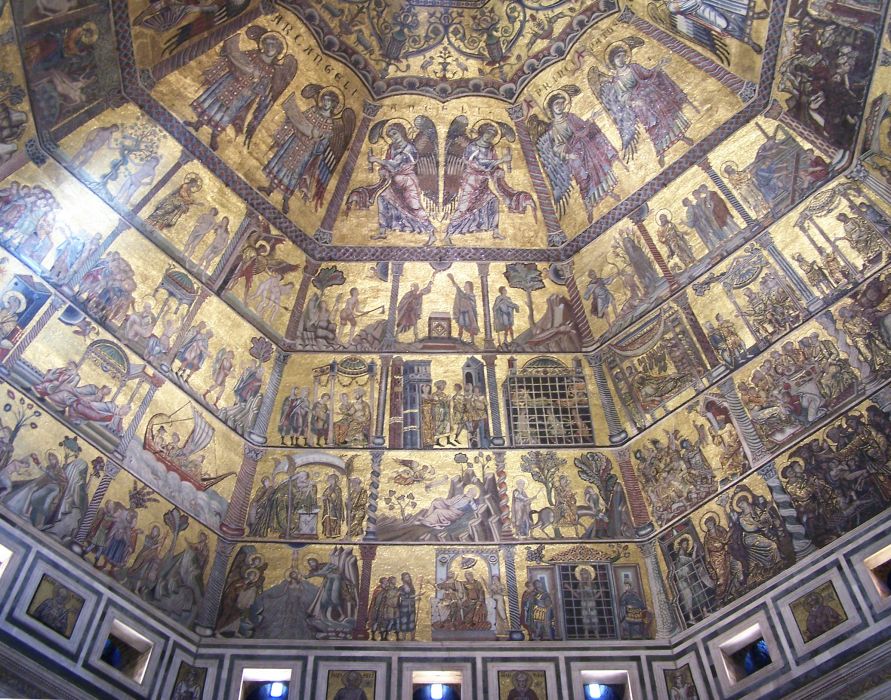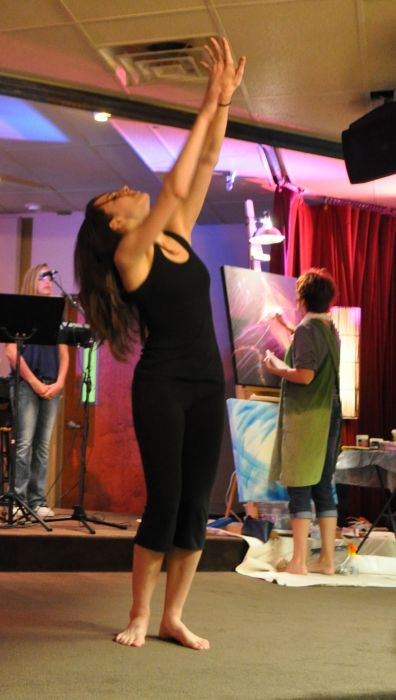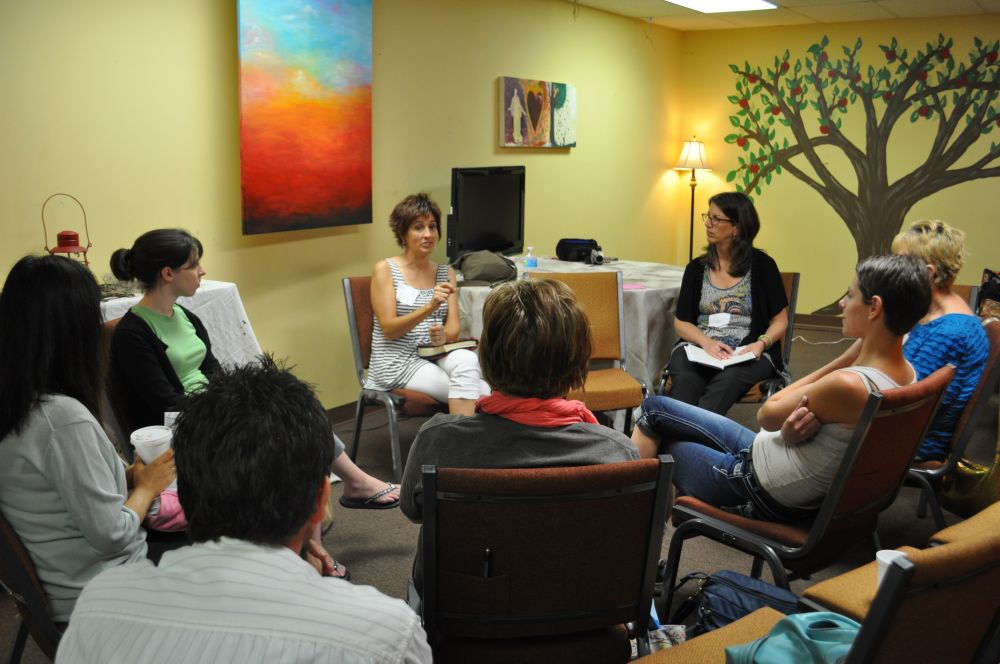By J. Scott McElroy and Jessie Nilo

Just imagine if the local church became the place in culture to experience beauty, creativity, and transcendence. Hundreds of years ago churches were, in many ways, centers for these experiences. Somehow, over time we’ve abdicated that role. Now, many churches are moving in that direction again and there’s a growing desire to begin developing creative arts programs (see Notes 1).
Many Christians are recognizing that God is calling us to reclaim the arts and renew the use of them in our churches. In many cases this means an “arts ministry” will be created to develop artists and projects. Some activities that might fit under the title of “arts ministry” in the local church include: creating performance pieces for services (e.g., drama, dance, spoken word, etc.),

creating live visual art for services (e.g., live painting during worship), creating gallery spaces for enjoyment and meditation (see Notes 9), creating art that is positioned permanently or seasonally behind the altar or around the sanctuary, creating interactive art, sensory, or “sacred space” experiences for the congregation, using the arts in community outreach (e.g., taking arts performances to nursing homes, shelters, schools, etc.), employing the arts as learning tools for youth, using the arts in counseling and therapy, using the arts spontaneously as a mean of conveying “prophetic” messages, offering arts classes and workshops, and much more.
Most churches around the world don’t currently have much in the way of arts ministry or programs, though there are talented artists in their congregations. If God has been nudging you, speaking to you about incorporating the arts into your church, below are a few thoughts on how to get started. Part One offers tips for artists, Part Two for pastors and leaders. It’s important to note that we believe the best way to develop a thriving arts ministry is to first build a strong arts community—a fellowship of artists—in your church.
Part One: For ARTISTS who want to start an arts ministry, program or outreach at their church
1. Start praying now for God’s guidance. First, it’s important to take some time to pray through what role God would have you play in starting or facilitating an arts ministry. Ask Him to check your motives, prepare your heart, and confirm if He is calling you personally to initiate or lead. It’s good to be clear about this because there will be challenges ahead. You may encounter increased spiritual warfare, so you’ll need prayer support. Ask someone else to pray with you about integrating the arts in your church and for God to open the doors. You want this to happen naturally, in God’s timing, and to not be forced. God has a plan for the arts and creativity in your church, and if you listen and wait He’ll share it with you and others (see Notes 2 for prayer inspiration and direction).
2. Talk with someone in leadership about integrating the arts into your church. Connect with leadership. Your senior pastor may or may not be the person to approach to start this dialogue; it may be the worship pastor or an elder who “gets” you. It’s common for churches to be entrenched in the “way we always do things,” so you need to be patient, respectful, and trustworthy in your approach. Try to determine what is important to your church and its leadership (e.g., outreach, discipleship, justice, community, etc.) and imagine how an arts ministry can further that mission. Put that in a presentation that makes sense to leadership. See if there is an official process for starting a ministry in your church. There may be an application you need to submit. If your church is more open to the arts, explore where leadership would like to go with the arts in the future. Ask for dates when arts projects would fit in to services. Get permission to hold a meeting for artists, if that seems to be the next step.
3. Invite artists to meet and pray. See if you can put a notice in the church bulletin inviting interested artists and creative types to meet at the church or a nearby coffeehouse to pray and talk about what integrating the arts into your church might look like. Use the time to pray, get to know each other, talk about possibly starting an arts ministry, gather contact information and circulate a survey (see Notes 3 for survey). Pray for needs, for healing, for projects, for commissioning. Maybe anoint each person with oil, if you do that kind of thing, or have everyone place

their hands on the person being prayed for. Foster connection! If you have a large group, break up into groups of four people or so. Talk about dates for another meeting, possibly a repeating time once a month or once a quarter. Try to make future meetings a time to connect and be authentic with other artists
4. Start off by doing a multi-week book study. When you start meeting regularly, it’s a good idea to build community and camaraderie among artists before launching into projects. One excellent way to do this is to start with a book study. This will help build relationships in the group; you’ll learn and grow together and create a unified vision. Great books for study are Heart of the Artist (Noland), Finding Divine Inspiration (McElroy)(FindingDivineInspiration.com for the workbook), Imagine That (Luz), The Creative Call (Elsheimer), and The Artist’s Way (Cameron). Unlocking the Heart of the Artist (Tommy) and Born to Create (Dedmon) work well for a more charismatic approach. Imagine (Turner), Walking on Water (L’ Engle), and Art and the Bible (Schaeffer) are classic books to read together, though they’re not necessarily designed for a book study. (See TheNewR.org bookstore for more books on art and faith.)
5. Initiate some projects. After you’ve built community and gotten to know each other for at least a few months, start exploring projects or ideas you might try as a group. It’s important to give your growing group of artists a project to work toward. Go back to Step 2 and think about how you can assist in the mission of the church. Take some time during the meeting to brainstorm and listen to God together, asking Him how you can collaborate with Him in the arts (see Notes 4). There are many project ideas that can get your artists, the congregation and leadership involved (see Notes 5 for ideas) and enhance the church’s mission. You may need to start slowly with projects that are easily grasped. In many cases you will be educating the congregation and/or leadership in how to engage with the arts in a church setting. After you develop some ideas, invite your pastor or a leader to a meeting to talk about how they might work, and about setting a vision for the arts in your church.
Other things that will activate the talent and enthusiasm of your artists might include having some of them offer a workshop on their area of expertise to the congregation, or starting an art gallery in the church (see Notes 9 ), or you might collaborate to put together a special mid-week arts service, or design holiday services. Even if no specific church projects are immediately available, you can still build momentum by continuing to meet and/or setting up monthly or quarterly “creative days” where artists eat, create, and encourage one another in their creative callings.
Part Two: For PASTORS AND LEADERS who want to start an arts ministry, program or outreach at their church
1. Seek God for His plan. Ask God to give you a vision for what He wants to do through the arts in your church. Just as pastors have specific messages from God for their congregations at specific times in history, so it is with the artists He has planted in your congregation. If you teach them to hear God’s voice they will bring powerful messages that enhance what He is doing in your congregation (see Notes 4). You might read a book like Heart of the Artist (Noland) or Finding Divine Inspiration (McElroy) to better understand how to disciple and encourage artists. The arts have endless applications in ministry; they can enhance worship, illustrate or enhance ideas and concepts, stir emotions, add beauty, enliven outreach, intuitively communicate God’s messages and more. God will use them in unique ways to convey His love to your congregation (see Notes 5 for ideas).
2. Pray for the right person to lead your artists. You want an arts ministry to develop naturally, in God’s timing, and to not be forced. Arts leaders can be difficult to find. Your ideal arts leader will probably need to be a mix of pastor and administrator. Their pastoral tendencies will be important to shepherd, encourage and understand the artists, and administrative skills will provide the follow-through that artists and artistic projects need. It’s helpful if the leader has artistic talent, but not mandatory as long as they understand the creative temperament. Make a commitment to disciple this person; they will be a huge asset to you and your church (see Notes 7).
3. Invite artists to meet and pray. When you have an arts leader, or at least someone who feels led to spearhead an arts effort, put a notice in the bulletin inviting interested artists and creative types to meet at the church or a nearby coffeehouse. Invite them to pray and talk about possibly starting an arts ministry. Use the time to gather contact information and circulate a survey (see Notes 3 for survey). Share the vision God has given you for the arts in your church. You might also take some time during the meeting to brainstorm and model how to listen to God together, seeking to collaborate with Him through the arts to bring His messages to your congregation. It’s very helpful to share the vision and values of the church with the artists and ask them to think about how the arts might enhance those.
4. Understand where they are coming from. Many artists have been offended by the church or Christians. Just spending time with them in this group setting will help them heal. You will bless them immensely if you take the time to pray for each of them individually at some point during the meeting. As these artists flourish, your congregation will flourish. When the arts and artists begin to integrate into a church, that congregation becomes more complete and mature because the Body of Christ is operating as it should, with each part and gift building up the other (Romans 12:4-6) (see Notes 8).
5. Help launch the ministry. Later, when you have an arts leader and they have built community with artists in the church, have them call another meeting—which you attend—to talk about specific arts projects you and they want to do. Your attendance will help commission them and clarify direction. NOTE: It is important to meet at least occasionally with your arts leadership. Discuss difficulties, challenges and dreams they have. Give them a list of dates, topics or services you’d like to see the arts integrated into, and reiterate the church’s mission and values. MAKE SURE you’ve spent time listening to them first. If you give them ideas first they may be overloaded. Help them to set up a plan for discipling the artists in their care. Let them know you and the church stand behind them.
With the guidance of the Holy Spirit, an arts ministry can open new doors of experience and understanding for your congregation and may become one of the richest and most enjoyable ministries of your church.
A historic movement is underway. It’s a movement that will connect artists with the ultimate Creator, awaken creativity in the average person, invigorate the local church, and convey God’s love to the world in authentic and creative ways.
It’s a New Renaissance, and you and your church have a part in it.
Notes:
- See a growing list of churches with Arts Ministries at http://TheNewR.org under “The Arts in Your Church,” “Church Arts Ministries.”
- “Prayers for the New Renaissance” provided at http://TheNewR.org in “Material and Ideas.”
- Arts Survey available at http://TheNewR.org in “Materials and Ideas.”
- See the book Finding Divine Inspiration (http://FindingDivineInspiration.com) for more on leading artists to hear God’s voice.
- See “Materials and Ideas” at http://TheNewR.org.
- For more information, ideas and resources go to The New Renaissance Arts Movement at http://TheNewR.org.
- Revolutionary Leadership by Tri Robinson is a good book to read and pass on to arts leaders. See this article: How the Church can Embrace the Arts: Pt. 2 for ideas on how to integrate the arts and maintain a standard of quality. (from http://jscottmc.wordpress.com)
- See this article, “The Arts and the Maturity of the Church.” (from http://jscottmc.wordpress.com)
- For great advice on church art galleries see this article: “How to Start an Art Gallery in Your Church” by Christopher Brewer (under “Articles” at http://TheNewR.org).
J. Scott McElroy is founder and director of The New Renaissance Arts Movement, the author of Finding Divine Inspiration: Working with the Holy Spirit in Your Creativity(Destiny Image) and director of arts at Vineyard Community Church, Indianapolis, Ind. He blogs at http://jscottmc.wordpress.com. Reach him at: Scott@TheNewR.org.
Jessie Nilo is director of church-artist connections for The New Renaissance Arts Movement, founder and director of VineArts, the arts ministry of Vineyard Boise Church, and a teacher at Fresco Arts Academy, Boise. VineArts operates with a team of 13 leaders that facilitates arts workshops, mission trips, outreaches, studies, a gallery and more. Their permanent studio is open weekly and provides space for the visual arts, writing, culinary arts, film, and design. Reach Jessie at: Jessie@TheNewR.org.

sheila whittam
I read with much interest as I have recently placed a proposal before the pastor and elders of my church. (Baptist Union of South Australia) I suggested that it take the form of weekly workshops searching for divine inspiration through making art , making the workshops available to community outreach in the context of a caring church. I have a BA Degree in Fine Arts, am a curator and galleria in the past, and also a practicing artist.
We already have an art group in the church setting which meets now and again. We had our first exhibition during Easter 2011 and it drew many from our community. Adelaide Hills has a real cultural setting with many professional artist and writers.
My main concern is that when church gets a touch of inviting art into its midst its efforts most often down the track become mediocre. The professional edge is most often lost. Yet this is needed for those who are looking at the church from the outside. This I believe is because it does not set standards. It is fine to look for well educated leadership in pastors and youth workers but art ideas fall into the lowest common denominator.
Your article sets out artistic excellence that is possible for the church. After all Christians should be an example of fantastic creativity as God made us in His image after His likeness.
It would help if artistic leadership could have some financial assistance as Christian workers do. If people think art is there for free provided by the church, the outcomes may be mediocre.
People put effort in when they are rewarded for their time and effort. Regards Sheila Whittam. http://www.sheilawhittam.com
jscottmcelroy
Thanks for your comment, Sheila!
Starting with workshops or a book study is an excellent idea. That is a a great way to get people on the same page and enjoying similar experiences. Its so important to build community and trust with artists instead of jumping right in to making things for the church.
You bring up a very good point about excellence. It is important to have standards of excellence for the art displayed or performed in our church, but I believe its also important to be inclusive of those with lesser skills. Similar to how everyone in the congregation gets to enjoy singing along with the music, but those on the stage need to be up to a certain standard, I think we should look for ways that more can enjoy creative expression, but what is displayed is held to a certain standard. I shared some thoughts on how to do that in the posts “How the Church Can Embrace the Arts Parts I and II” in August and September ’09.
We are seeing changes in the valuation of art in the church, and one day I believe it will be commonplace to see art and creativity flowing in churches. In many churches we are still in the pioneering stage, so budget and finances are hard to come by. But hang in there, God is at work in the arts!
Blessings!